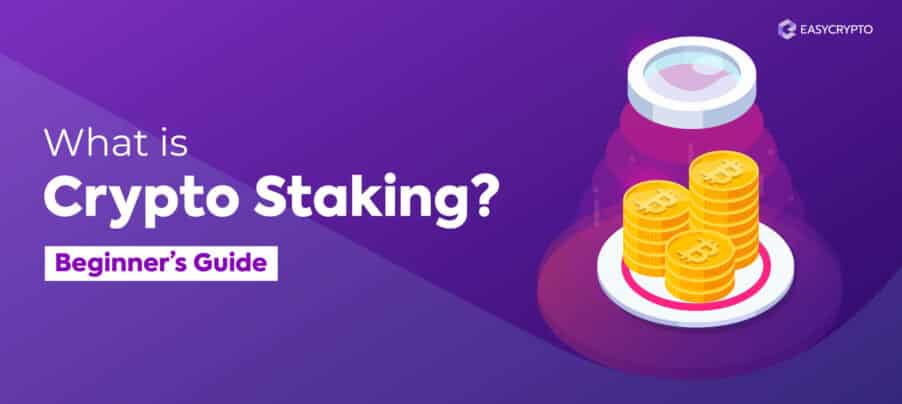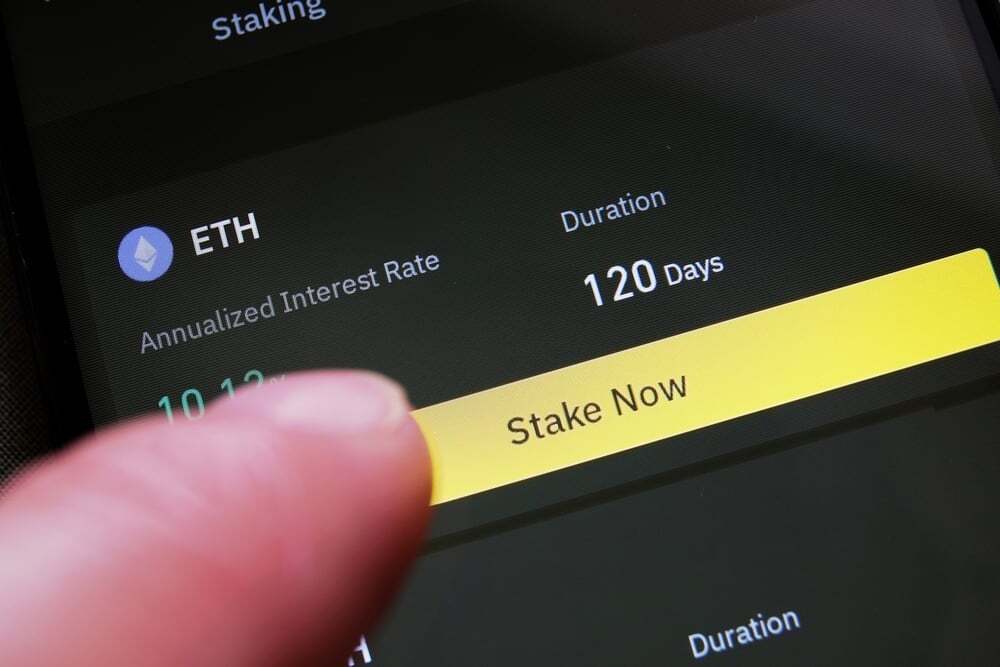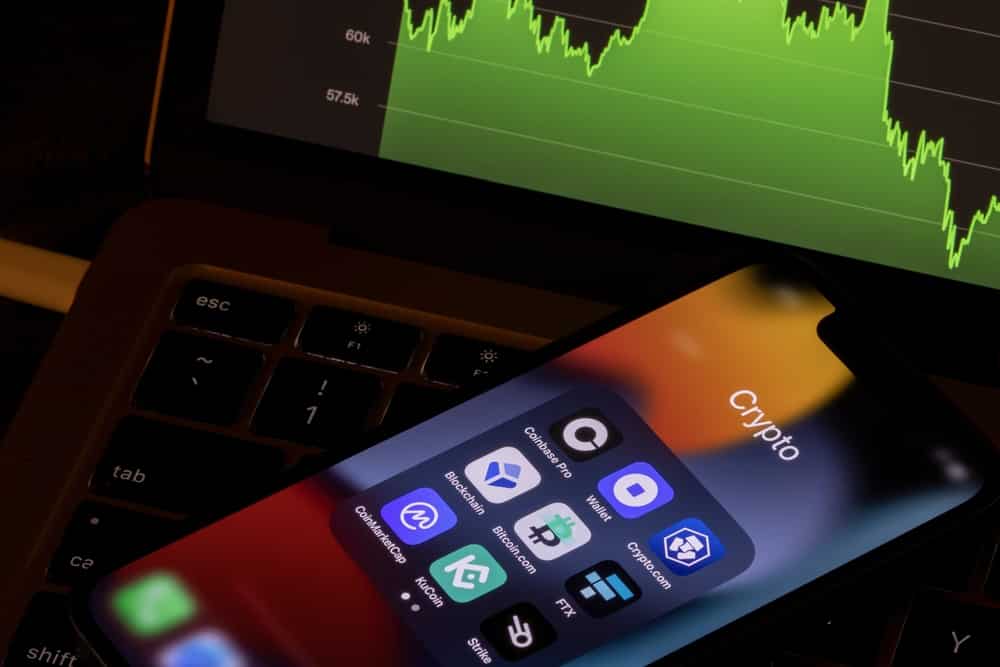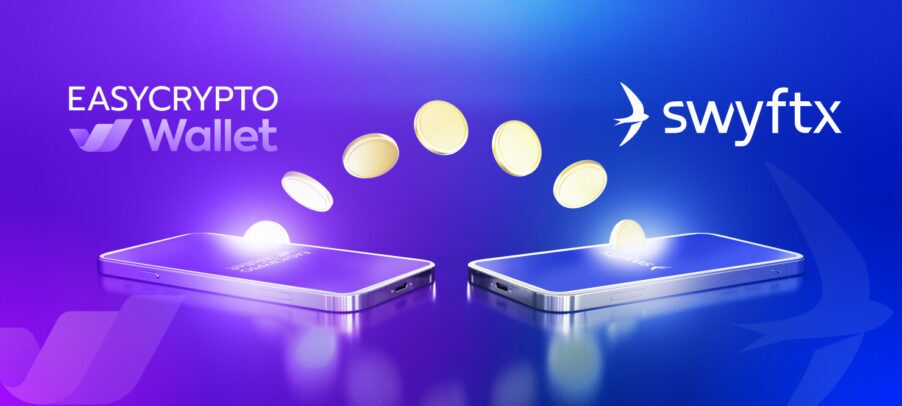What is Crypto Staking? A Beginner’s Guide
You can earn passive income by staking your crypto. But how is that even possible? Here’s an introductory guide to crypto staking for beginners.


Staking allows you to earn passive income in cryptocurrency. In principle, you stake by “locking up” your cryptocurrency into a staking wallet. After a period of time, you will accumulate more cryptocurrency in that staking wallet. Sounds simple, right?
Of course, you want to know how the whole thing works. What is the purpose of staking? Who will benefit from this system? How much can you expect to earn from staking, and which cryptocurrency allows for staking?
Read this guide and you will know more about crypto staking, so that you can get started really soon!
New to crypto? Familiarise yourself with the concepts in this article such Decentralised Finance (DeFi) and Proof of Stake (PoS).
What is staking in crypto?
Staking is as simple as depositing your cryptocurrency into a staking wallet, and then waiting for a while. This simple act, however, has a far reaching positive impact on other people. Generally speaking, there are two “types” of staking, because staking has one of two purposes:
- It helps keep the crypto network decentralised and secure.
- It adds liquidity for traders to borrow crypto in order maximise their trading returns.
Take note that ‘staking’ is an umbrella term that describes the act of depositing crypto into a staking wallet. How it works depends on the purpose of staking.
This will become much clearer when we use real examples.
Staking keeps the network decentralised and secure
As you know, cryptocurrency is decentralised money. There is no centralised authority that checks and validates transactions and balances. There is also no centralised authority to issue that currency.
In this environment, the only way to ensure that your cryptocurrency balance is accurate and true is to rely on a group of independent validators.
These validators will do the accounting work for everyone, and do not trust other validators’ work. The more validators there are in a network, the fewer points of weakness in the network. In a network where there are only so few validators, it is easier for attackers to take over more than half the network.
The key takeaway is this: The more validators, the merrier.
Staking is done by validators to provide assurance
So, how does staking come into play? Certain crypto networks like Cardano (ADA), Polkadot (DOT), Luna (LUNA), and Binance Coin (BNB) require validators to “stake” their cryptocurrency.
These networks are known as Proof of Stake networks. In this network, in order to become a validator, you have to provide proof that you have staked cryptocurrency in order to earn staking reward (newly minted cryptocurrency).
By staking, validators provide assurance to the network. By putting aside (often) large sums of crypto, they are ready to become the best validators they can be, or risk getting penalised.
If they ever go offline for too long, or worse, get caught manipulating transactions, then a considerable amount of their staked crypto will be taken away automatically. This is also known as slashing.
Staking can be delegated
By now, you might be feeling a bit sceptical about staking, “Punishment for going offline? Staking to validate transactions? That sounds complicated for me!”
Luckily, staking can be delegated. This means someone with the money can work together with someone with the technical know-how. A group of people who delegate their crypto to a validator is known as a staking pool.
Once you delegate your stake to a staking pool, you will earn a share of the validator’s staking reward. In other words, you will be paid in new coins that has never been owned by anyone!
Finding a staking pool is easy. Most wallets provide an option to browse for staking pools. Here’s an example with the Yoroi wallet for Cardano, which you can check out here.
If you have a multi-coin wallet, such as Exodus, you can also easily stake cryptocurrencies such as Cardano (ADA), Cosmos (ATOM), Neo (NEO), Algorand (ALGO), and more.
You’ll notice that while staking with a wallet or exchanges can give you a wide variety of cryptocurrencies to stake, there is a lack of variety in choosing your staking pool.
For Cardano alone, for example, there are dozens of staking pools available to delegate your ADA coins to. Each staking pool has their own scoring metrics, like activity, return on investment, pool size, and cost metrics like commissions or fees. This information is not found in wallets or exchanges.
Not sure if a staking pool is safe for you? Feel free to send us an inquiry, and we’ll help you!
Staking crypto in exchanges
In some exchanges, whether centralised or decentralised, you can stake various kinds of coins and tokens, for example AAVE, an ERC-20 token.
There is no issue with staking tokens at all, but you should be aware that staking some tokens will not earn you any staking reward. Instead, you will earn interest on that staked asset. “What difference does it make?” you ask.

The former type of staking is used to secure a crypto network, so you will be guaranteed by the network, or by the staking pool, that you will earn some kind of reward.
However, the other type of staking is used to provide liquidity to exchanges. Some platforms would give you fluctuating staking rewards, and a few others could just be a rug pull scam (more below).
How staking crypto helps traders make money
To explain this better, let’s learn a bit about how traders with a limited starting capital can earn decent dollars by trading.
First, they have a starting capital, also known as a ‘margin’. Let’s say they have $100 worth of USDT to start with — not a lot. The exchange can lend the trader $900 of USDT for a short time. The trader can now buy $1000 worth of assets, say BTC, in the open market.
If BTC goes up by 1%, the $1000 of BTC will now be worth $1010. If the trader closes the trade, they must return the $900 of borrowed USDT plus any fees, leaving $110 in their balance.
The $100 has been their margin, and the $10 is the profit. Without relying on the extra $900 of liquidity, the trader wouldn’t be able to make $10 with their initial $100 of margin.
Trading is a big business in the crypto world. “Staked” crypto helps exchanges make money from commissions, because staking provides liquidity from crypto that is not being spent.
It’s no surprise that decentralised exchanges could offer ridiculously high “staking yields” for early investors. It’s a reward for taking the risk of trusting a new platform.
Is it safe to stake in an exchange?
When you stake to provide liquidity, you are essentially expecting to be paid back in interest. Interest rates can initially be very high to attract investors, at the discretion of the developers.
If the decentralised exchange uses a decentralised voting system, then decisions regarding the interest rate levels may go to those with the highest number of the platform tokens, which are often the early developers and some prominent investors.
Decentralised exchanges are unregulated and are not backed by any jurisdiction’s laws. Therefore, there is always a risk of a rug pull scam.
A rug pull scam is a type of scam where the developers of a platform decide to shut down all operations after having seen enough investor crypto deposited into their wallets.
If you see a new platform with unbelievably high staking yields, be aware that it could be a rug pull scammers’ trap. If you decide to try it out anyways, in case it’s not a rug pull scam, then by all means risk no more than what you’re willing to lose.
How much can you earn by staking?
The answer really depends on what you’re being offered.
There is no standard market for staking. Some can offer you incredibly high yields to attract early stakers (always keep in mind that it could be a scam). Others offer relatively low yields, but remember that it could be much higher than what is offered by traditional banks.

For Proof of Stake network staking, consider if becoming a validator is for you. If that’s the case, read up the documentation provided by each blockchain’s official website.
If you decide to join a staking pool, consider things like fees, reward shares, the validator’s performance history, locking period, how much crypto has been delegated, and more.
There’s always room to do your own research because the crypto space is dynamic and constantly evolving. Please let us know if you’ve successfully set up a validator node!
Share to
Stay curious and informed
Your info will be handled according to our Privacy Policy.
Make sure to follow our Facebook, Twitter, Instagram, and YouTube channel to stay up-to-date with Easy Crypto!
Also, don’t forget to subscribe to our monthly newsletter to have the latest crypto insights, news, and updates delivered to our inbox.
Disclaimer: Information is current as at the date of publication. This is general information only and is not intended to be advice. Crypto is volatile, carries risk and the value can go up and down. Past performance is not an indicator of future returns. Please do your own research.
Last updated February 2, 2024





